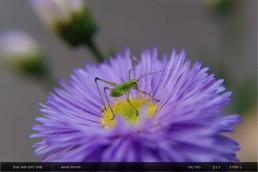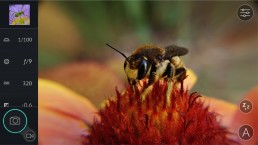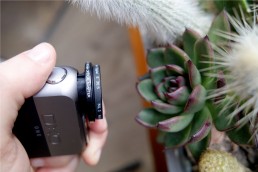La macrofotografía Los accesorios
Busque ángulos originales y tenga paciencia.
Juegue con el diafragma para modular la nitidez.
La macrofotografía consiste en fotografiar sujetos pequeños, principalmente la flora o la fauna. Esto requiere observación, paciencia, luz y algo de técnica.
En cuanto al material, puede instalar en la DxO ONE lentes macro o Close-Up Lens de a partir de 30,5 mm de diámetro, gracias al accesorio DxO ONE Optical Adapter.
En macrofotografía, estará cerca del sujeto y la zona de nitidez será más reducida. Para jugar con la profundidad de campo, utilice el modo de prioridad a la apertura (modo A) y cierre progresivamente el diafragma del objetivo de su DxO ONE en función del detalle deseado.
(Fotógrafo Anais Phinith)
Si fotografía a mano alzada, vigile la velocidad de obturación para evitar un desenfoque si hay un poco de viento o si el sujeto se mueve. En estas condiciones, no descienda por debajo de 1/125 s: debe buscar el equilibrio entre una velocidad elevada para obtener una imagen nítida, un diafragma bastante cerrado para conseguir una nitidez suficiente y una sensibilidad baja para conservar una buena calidad de imagen.
Si la velocidad es lenta (1/30 s o menos) y/o si el sujeto está fijo, utilice un trípode para garantizar un enfoque muy preciso. Active el temporizador o utilice la DxO ONE en Wi-Fi para disparar a distancia y evitar cualquier movimiento que pudiera desplazar el punto de nitidez.
Si no consigue enfocar, cambie al modo de enfoque manual M para ajustar usted mismo la nitidez con ayuda de la regla y la lupa de visualización detallada en la pantalla de su smartphone.
Busque una composición original y varíe los ángulos. Gracias a su tamaño reducido, la DxO ONE cabe en todas partes. También puede colocarla en el suelo para darle un efecto de relieve al sujeto. Utilice el contraluz para resaltar la transparencia de un vegetal.
(Fotógrafo Florence AT)
Los sujetos con fuertes contrastes aportan relieve. Para esto, el modo de medición puntual es el más adaptado. Analizando una zona reducida determinada con la punta del dedo, permite realizar capturas a contraluz.
Para aclarar una sombra, utilice un pequeño reflector. Un simple cartón blanco casero servirá perfectamente y puede también usarlo para esconder un fondo poco agraciado.
Para guardarlas, nombre sus fotos con las especies de insectos y vegetales fotografiadas.
Por último, por respeto al medio ambiente, evite alterar el entorno en el que fotografíe.






 Télécharger la page
Télécharger la page